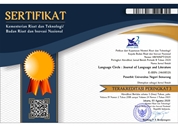Vowel Space Area of Minangkabau Learners of English
(1) Faculty of Teacher Training and Education, Universitas PGRI Yogyakarta, Indonesia
(2) Faculty of Humanities, Leiden University Centre for Linguistics, The Netherland
(3) Faculty of Teacher Training and Education, Universitas Muhammadiyah Sumetera Barat, Indonesia
Abstract
Vowel spacearea (VSA) represents kinematic movements of the articulators and measures speech intelligibility. By looking at the vowel space area, the current study intends to examine the role of Minangkabau in the acquisition of English as a second language. We conducted a speech production experiment involving ten English monophthongs in isolated sentences. We measured the formant frequencies (F1/F2) values and computed the vowel quadrilateral. The results showed that the Minangkabau learners of English did not have similar VSA pattern when compared to the native English speakers. They did not open the jaws and move the tongues as similar as the native English speakers in pronouncing English vowels. The results were discussed in the area of second language acquisition.
Keywords
acoustic measurement, formant frequencies, L2 acquisition, vowel space area
Full Text:
PDFRefbacks
- There are currently no refbacks.

This work is licensed under a Creative Commons Attribution 4.0 International License

